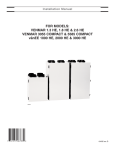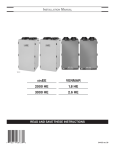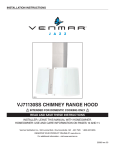Download Venmar HR 2.6 User manual
Transcript
USER MANUAL READ AND SAVE THESE INSTRUCTIONS VB0181 VÄNEE 2000 HE 3000 HE VENMAR 1.8 HE 2.6 HE ADDRESS OF YOUR INSTALLER RESIDENTIAL PRODUCTS GROUP, 550 LEMIRE BLVD., DRUMMONDVILLE, QC, CANADA J2C 7W9 02053 REV. 06 ABOUT THIS MANUAL Congratulations! You have made an excellent choice! The operating principle of your Heat Recovery Ventilator will protect your house and give you personal comfort you have never known before. We have prepared this User Manual especially for you. Please read it carefully to ensure you obtain full benefit from your Heat Recovery Ventilator unit. Over the coming months, you will increasingly appreciate the feeling of living in a more comfortable house. Please take note this manual uses the following symbols to emphasize particular information: ! WARNING Identifies an instruction which, if not followed, might cause serious personal injuries including possibility of death. CAUTION Denotes an instruction which, if not followed, may severely damage the unit and/or its components. NOTE: Indicates supplementary information needed to fully complete an instruction. We welcome any suggestions you may have concerning this manual and/or the unit, and we would appreciate hearing your comments on ways to better serve you. Please forward all correspondence to us at the address indicated on the product registration card included with this manual. CAUTION Make sure at all times that the outside hoods are free from any snow during the winter season. It is important to check your unit during a big snow storm, so it doesn’t draw any snow. If this is the case, please operate the unit in recirculation mode, or OFF mode, for a few hours. Do not use your HRV during construction or renovation of your house or when sanding drywall. This type of dust may damage your system. Since the electronic control system of the unit has a microprocessor incorporated, it may not operate correctly because of the external noise or very short power failure. If this happens, unplug the unit and wait approximately 10 seconds. Then, plug the unit in again. CAUTION When leaving the house for a long period of time (more than two weeks), a responsible person should regularly check if the unit operates adequately. If the ductwork runs through an unconditioned space (e.g.: attic), the unit must operate continuously except when performing maintenance and/or repair. Also, the ambient temperature of the house should never drop below 18°C (65°F). At least once a year, the unit mechanical and electronic parts should be inspected by qualified service personnel. 2 TABLE OF CONTENTS 1. FUNCTIONS OF YOUR HRV .................................................... 4 1.1 AIR EXCHANGE . . . . . . . ..................................................................... 4 1.2 HEAT RECOVERY . . . . . ...................................... ................................ 4 1.3 RECIRCULATION . . . . . ...................................... ................................ 4 2. DIAGRAMS OF AIRFLOW ...................................................... 5 3. DESCRIPTION OF THE UNIT .................................................. 6 4. MAIN AND AUXILIARY CONTROLS ........................................... 7 5. MAINTENANCE ................................................................ 7-8 5.1 REGULAR MAINTENANCE ................................... ................................ 7 5.2 ANNUAL MAINTENANCE ..................................................................... 8 6. TROUBLESHOOTING .......................................................... 8 REPLACEMENT PARTS AND REPAIRS In order to ensure your ventilation unit remains in good working condition, you must use the manufacturer genuine replacement parts only. The manufacturer genuine replacement parts are specially designed for each unit and are manufactured to comply with all the applicable certification standards and maintain a high standard of safety. Any third party replacement part used may cause serious damage and drastically reduce the performance level of your unit, which will result in premature failing. Also, te manufacturer recommends to contact a certified service depot for all replacement parts and repairs. 3 1. FUNCTIONS OF YOUR HRV Your Heat Recovery Ventilator eliminates the excessive humidity problems by exhausting stale and humid air to the outdoors and by drawing in fresh air. The unit offers superior air quality and fresh air sensation, an important factor to overall comfort, by eliminating the accumulation of pollutants and humidity. The unit also comes equipped with a heat recovery core which reduces ventilating costs in winter. The Heat Recovery Ventilator is a ventilation system which carries out three main operations: 1.1 AIR EXCHANGE The unit exhausts stale and humid air from the house and replaces it with fresh air from the outdoors. MODELS RATES 2000 HE / 1.8 HE 55 to 93 l/s (115 to 197 cfm) 3000 HE / 2.6 HE 85 to 141 l/s (180 to 300 cfm) 1.2 HEAT RECOVERY During winter, the unit recovers the heat contained in the stale air before it is exhausted, and transfers it to the fresh air drawn from the outdoors (reverse process in summer). Example (in winter): Fresh air from outdoors 0°C/32°F Stale air to outdoors 3°C/37°F Stale air from building 22°C/72°F Fresh air to building 19°C/66°F VF0024 1.3 RECIRCULATION During the recirculation mode, the units stops to exchange air with the outdoors. Continuous recirculation is thus undertaken inside the home and insures the purification of the ambient air. Two mechanical filters trap the large dust particles (those visible to the eye). 4 2. DIAGRAMS OF AIRFLOW During air exchange STALE AIR FRESH AIR STALE AIR TO BUILDING TO OUTDOORS FROM BUILDING FRESH AIR FROM OUTDOORS During recirculation and defrost mode STALE AIR FILTERED AIR TO BUILDING VF0025 VF0002 5 FROM BUILDING 3. DESCRIPTION OF THE UNIT 4 1 14 2 3 12 5 6 7 8 7 11 13 5 9 10 VL0012 1 Stale air intake port: 2 3 4 5 6 7 8 9 10 11 12 13 14 is connected to the registers located in the larger rooms of the house. Fresh air port: brings fresh air from the outdoors into the unit. Exhaust port: exhausts stale air to the outdoors, after the air has transferred its heat inside the heat recovery core. Distribution port: distributes fresh air into the house, after it has absorbed the heat of the stale air in the heat recovery core. Mechanical filters: trap the dust contained in the air and prevent the heat recovery core from becoming obstructed. Heat recovery core: is a counterflow type. It transfers the heat between the two air streams. Blowers: draw fresh air from outdoors and exhaust stale air to outdoors. The blower wheels are driven by two motors. Capacitor: is indispensable to proper motor operation. Condensation tray: is used to capture the water produced during heat transfer and defrost (in cold climate). Drainage tube: is connected to the condensation tray and serves to drain the water within. Electronic circuit: located inside the electrical box, insures proper operation of the unit. Automatic defrost unit: consists of one damper actuator, dampers and related controls. The defrost cycle is electronically controlled in response to the outdoor temperature (-5°C [23°F] to -40°C [-40°F]) and will increase in frequency as the temperature decreases. Its duration is of 5 or 6 minutes according to models. Control connector: located inside the electrical box, allows to connect the main and auxiliary controls. Electrical cord: for 120 V electrical supply. 6 4. MAIN AND AUXILIARY CONTROLS Only one main control can be connected per unit, but up to 5 auxiliary controls can be connected to the unit. NOTE: If an optional auxiliary control is used, its activation will override the main control operation. For more information about your unit controls, refer to the Main and auxiliary wall controls user guide (included with your unit and also available at www.vanee.ca [for 2000 HE and 3000 HE units] and at www.venmar.ca [for 1.8 HE and 2.6 HE units]). 5. MAINTENANCE ! WARNING Dangerous voltage may be present. During maintenance and repairs, the unit must always be turned off, then unplugged. We take great care to minimize sharp edges; however, please proceed with caution when handling all components. When cleaning the unit, it is recommended to wear safety glasses and gloves. 5.1 REGULAR MAINTENANCE 1. The motors are factory lubricated for life. Lubricating the bearings is not recommended. CAUTION Because the unit is suspended, two people are recommended to remove or install the heat recovery core. Do not hold the heat recovery core using its plastic extrusions as handles. 2. The heat recovery core must be handled with care. We recommend that it be washed once a year, following the season of most intense use, in order to insure maximum efficiency of the plastic partitions. Allow the heat recovery core to soak for 3 hours in a solution of warm water and mild soap. Rinse thoroughly. CAUTION Hot water and a strong detergent will damage the heat recovery core. 3. The air filters are washable. Under normal conditions, we recommend that they be washed every 3 months. Use vacuum cleaner to remove the heaviest portion of accumulated dust, then wash in hot water. 4. Regularly check the screen on the exterior intake hood and clean when necessary. Also check during very cold weather because ice may grow on the screen located at the exterior intake hood. 7 5. MAINTENANCE 5.2 ANNUAL MAINTENANCE NOTE: Ask your installer for an annual service contract. Annual service should include: 1) Cleaning filters, heat recovery core and the exterior air intake/exhaust hood. 2) Cleaning the wheels and the blower blades. 3) Cleaning the condensation tray with soapy water (make sure that the drain is not clogged). 4) Running the system and checking the different operating modes. 5) Measuring and calibrating (if need be) rates of flow. 6. TROUBLESHOOTING PROBLEM YOU SHOULD TRY THIS 1. Nothing works. • See if the unit is plugged in. • See if the unit is receiving power from the house circuit breaker or fuse. 2. Noisy unit. • Clean the unit (see Section 3). If the problem is not solved, contact your installer. 3. Condensation on windows (air • Operate the unit at maximum speed (MAX.) too humid). during activities generating excess humidity (family gatherings, extra cooking, etc.). • Leave curtains half-open to allow air circulation. • Store all firewood in a closed room with a dehumidifier or in a well ventilated room, or store the wood outdoors. • Keep the temperature in your house above 18°C (64°F). 4. Air too dry. • Operate the unit at low speed (MIN.). • Temporarily switch to the intermittent mode. • Temporarily use a humidifier. 5. Air too cold at the air supply • Make sure the outdoor hoods are not blocked. grille. • Operate the unit at low speed (MIN.). • Have the system’s balancing checked. • Have the unit’s defrost system checked. • Install a duct heater. For wall controls problems, refer to the Troubleshooting section in the Main and auxiliary wall controls user guide (included with your unit and also available at www.vanee.ca [for 2000 HE and 3000 HE units] and at www.venmar.ca [for 1.8 HE and 2.6 HE units]). If the problem is still not solved, call your installer or the nearest approved Service Center. You can also reach the Customer Service Department at the following phone number: 1-800-567-3855. 8





















